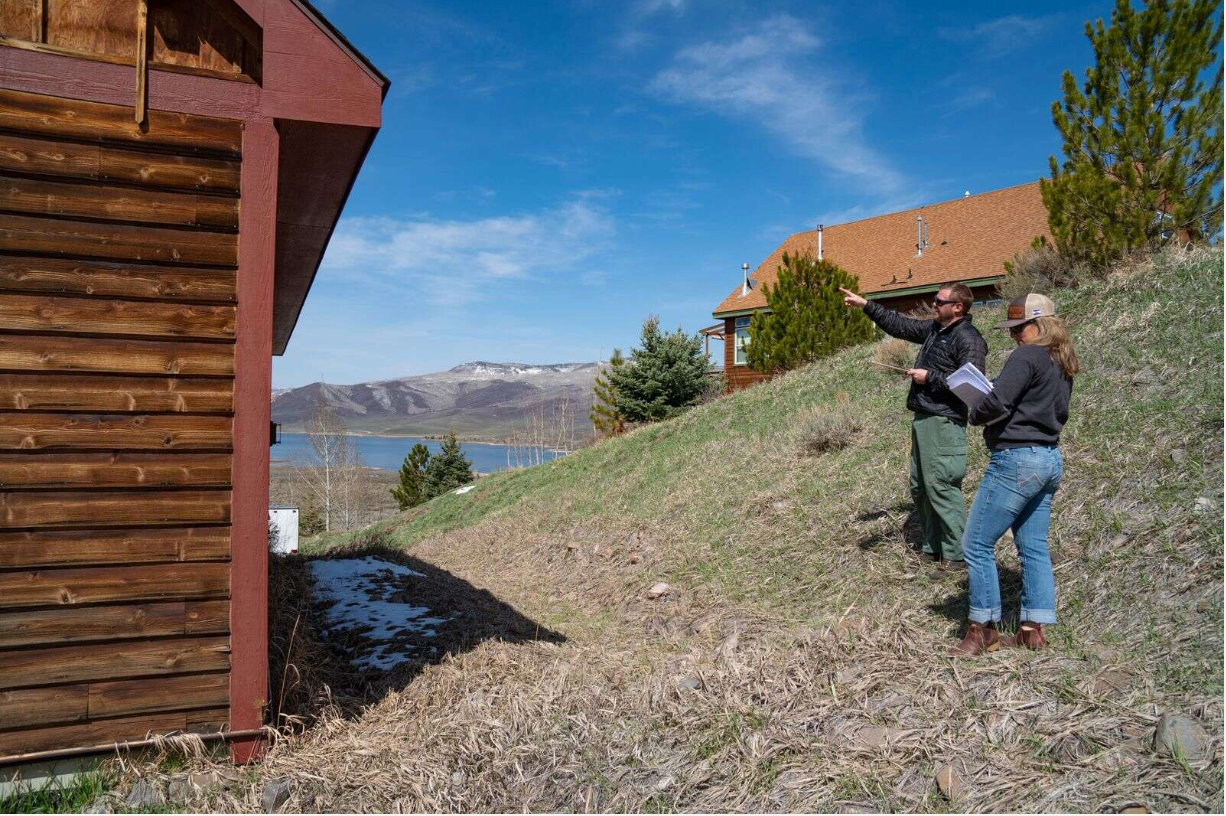Harden your home: How property owners can protect their house from fire danger, assist firefighters

Wildland Program Director Sally Ross, front, and Wildland Coordinator Rob Rydberg with the Oak Creek Fire Protection District perform a property fire risk inspection in Stagecoach.
Oak Creek Fire Protection District/Courtesy photo
Wildfire experts call the process “hardening a home,” or creating defensive space, which is what homeowners need to do if they want wildland firefighters to try to defend their home during an emergency.
When trying to protect multiple homes, firefighters with limited resources must make tough decisions to rate a property as defensible or non-defensible, said Oak Creek Fire Chief Brady Glauthier.
With more homes built in the wildland-urban interface, those defensible or non-defensible choices are happening more often across Colorado. That’s where homeowners’ previous actions to create a defensive space around their homes can make the key difference when firefighters are in triage mode.
“If you don’t make time to harden your home, with limited resources, we may elect to not leave resources at your home. You have to give us a fighting chance,” Glauthier said hoping to get the attention of homeowners.
Firefighters may pass up defending a home if the access lane is dangerous and overgrown or if a home does not look like it has been prepared with fire mitigation efforts.
“All the parameters are indicating yet another difficult, if not a record-breaking wildfire season, and homeowners have to do the work,” said Fire Chief Chuck Cerasoli with Steamboat Springs Fire Rescue. “People have to step up and help themselves. We are small departments, and when we triage homes, we have to choose how to spend our time best in those emergency situations.”
All homeowners, even those who live in municipal neighborhoods, need to take precautions to harden their homes from the dangers of flying embers, especially after seeing the destruction of recent fires in Boulder and Grand counties, Cerasoli said.
This year, local fire departments and the Colorado State Forest Service are providing more personnel, outreach and focus on free property and structure fire assessments, especially for homeowner association or neighborhood groups. SSFR hired two seasonal wildland firefighters for many duties, including home inspections when available.
These structure inspections for fire danger and mitigation advice are available to property owners by request, with a preference for small group training to reach more people, Cerasoli said. Advice to homeowners might come through initial phone conversations and in-person site visits as personnel are available, said Carolina Manriquez, a local forester with the Colorado State Forest Service.
Residents and property owner associations can reach out for information or inspections to the Routt County Wildfire Mitigation Council via info@routtwildfire.org or reach out to their respective fire chiefs.
During the 2022 Routt County Wildfire Mitigation Conference on April 30, property owners were able to start work on individual or community wildfire preparedness plans. One good resource for checklists and planning is the CSFS Home Ignition Zone, which is available online via CSFS.colostate.edu.
Cerasoli encourages homeowners to look at their home with a new eye, thinking in terms of flying embers and envisioning what can catch on fire. The chief said inspections focus on reducing fuels within 100 feet of rural homes and within 30 feet of homes in residential neighborhoods.
Homeowners should remove ladder fuels or linkages of combustible materials leading to their homes. During one recent property inspection, for example, Cerasoli said the homeowner had a metal roof but had a shed with flammable wood shingles attached to the home.
The Steamboat fire chief’s top irritation is homeowners who leave wood piles next to their homes during the warm, dry months. He suggests maintaining a woodpile 30 feet from the home in the summertime. In the winter, homeowners can move smaller portions of firewood closer to their home.
Cerasoli said another item atop his fire danger list is having wood chips or mulch next to a home, wooden decks, wooden patio furniture, flammable patio furniture cushions and propane tanks close to a home.
Cerasoli said property owners should do what they can immediately to reduce wildfire risk, and then make a list to tackle as time and finances allow. For example, a home with a metal roof but with dry, aging cedar siding should be added to the to-do list.
“We encourage people to start doing something, start looking at their home differently, and every bit they do is going to make a little bit of difference,” Cerasoli said.
